Édouard Baldus
Édouard Baldus (5 June 1813, Grünebach, Prussia – 1889, Arcueil) was a French landscape, architectural and railway photographer.
Édouard Baldus | |
|---|---|
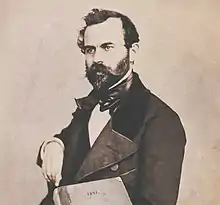 Édouard Baldus, Self-portrait (c. 1853). | |
| Born | 5 June 1813 Grünebach |
| Died | 22 December 1889 Paris |
| Occupation | Photographer |
Biography
Early life
Édouard-Denis Baldus was born on 5 June 1813 in Grünebach, Prussia. He was originally trained as a painter and had also worked as a draughtsman and lithographer before switching to photography in 1849.
Career
In 1851, he was commissioned for the Missions Héliographiques by the Historic Monuments Commission of France to photograph historic buildings, bridges and monuments, many of which were being razed to make way for the grand boulevards of Paris, being carried out under the direction of Napoleon III's prefect Baron Georges-Eugène Haussmann. The high quality of his work won him government support for a project entitled Les Villes de France Photographiées, an extended series of architectural views in Paris and the provinces designed to feed a resurgent interest in the nation's Roman and medieval past.
In 1855, Baron James de Rothschild, President of Chemin de Fer du Nord, commissioned Baldus to do a series of photographs to be used as part of an album that was to be a gift to Queen Victoria and Prince Albert as a souvenir of their visit to France that year. The lavishly bound album is still among the treasures of the Royal Library at Windsor Castle. In 1856, he set out on a brief assignment to photograph the destruction caused by torrential rains and overflowing rivers in Lyon, Avignon, and Tarascon. He created a moving record of the flood without explicitly depicting the human suffering left in its wake.
Innovations in photography
Baldus was well known throughout France for his efforts in photography. One of his greatest assignments was to document the construction of the Louvre museum. He used wet and dry paper negatives as large as 10x14 inches in size. From these negatives, he made contact prints. To create a larger image, he put contact prints side by side to create a panoramic effect. He was renowned for the sheer size of his pictures, which ranged up to eight feet long for one panorama from around 1855, made from several negatives.
Despite the documentary nature of many of his assignments, Baldus was inventive in overcoming the limitations of the calotype process (described here). He often retouched his negatives to blank out buildings and trees, or to put clouds in white skies; in his composite print of the medieval cloister of St. Trophime, in Arles (1851), he pieced together fragments of 10 different negatives to capture focus in depth in a panoramic view of the interior space and also render detail in the brightly lit courtyard outside.
Death
He died in 1889 in Arcueil, France.
Notable photographs
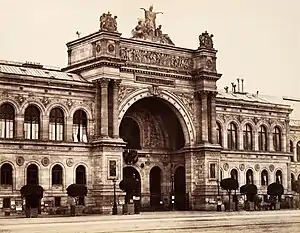 Palais de l'Industrie, c. 1860.
Palais de l'Industrie, c. 1860.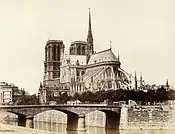
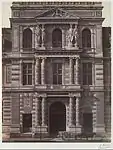 Imperial Library of the Louvre
Imperial Library of the Louvre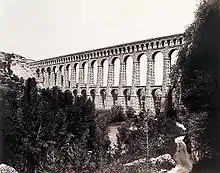
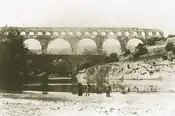
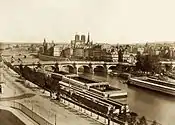 Panorama of Paris, about 1860
Panorama of Paris, about 1860
References
- Daniel, Malcolm, The Photographs of Édouard Baldus, with an essay by Barry Bergdoll. New York: The Metropolitan Museum of Art; Montreal, Canadian Centre for Architecture, 1994, ISBN 0-87099-714-9, ISBN 0-87099-715-7.
- Lindlein, Peter, The Secret of Edouard Baldus Revealed, Essay, PDF on www.lindlein.com, 2010
External links
- The Photographs of Edouard Baldus article on his photographic style
- Some of Baldus's photographs
- Lee Gallery
- "The Secret of Edouard Baldus Revealed" — with Baldus' photographs.
- The Photographs of Édouard Baldus: Landscapes and Monuments of France
- Édouard Baldus, photographs, Canadian Centre for Architecture (digitized items)